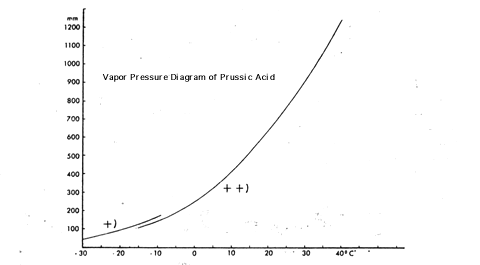| Text: Deutsch English |
 | Once More: The Efficiency of Prussic Acid at Low Temperatures |
||||||||
 |
 |
37
The relatively favorable evaporation speed even below the freezing point temperature is straight away explained by the vapour pressure prevailing at those temperatures, that at -28° C still amounts to around 50 mm. The diagram in illustration 2 indicates the dependency of the vapour pressure on the prussic acid temperature above and beneath its freezing point.
![]()

Illustration 2. Diagram.
**) From
G. Bredig and L. Teichmann. Z.S. Elch 31, 449; 1925.
![]()
Summary.
As a result of the experiments it can be considered to have been proven that absorbed prussic acid both at significantly low temperatures and above its freezing point, can be brought to evaporation sufficiently quickly that the requited gas strength for delousing activities can be achieved within the usual time-frames. Admittedly, the release of the gas is significantly slowed down at low temperatures; but even at -20 C more than half the prussic acid is released within 3 hours. The remaining evaporation occurs at this temperature approximately within 7-8 hours, unless it is delayed by excess dampness or formation of snow on the evaporation surface. With the corresponding slowing down of the reaction time a successful thorough gassing with prussic acid in these circumstances is technically not hindered. The biological reaction of prussic acid at low temperatures has already been reported on.
| Text: Deutsch English |
 | Once More: The Efficiency of Prussic Acid at Low Temperatures |
||||||||
Last modified: March 7, 2011
Technical/administrative contact: webmaster@holocaust-history.org